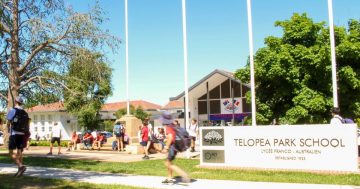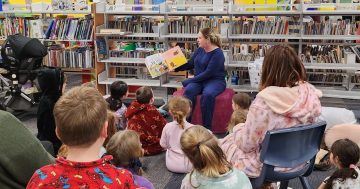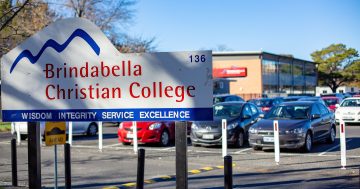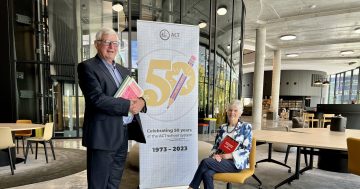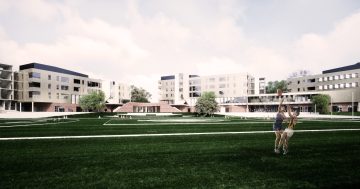Big Al: The Government identified the possibility of closing up to 39 schools in this year’s budget. Do you think that that number will be sufficient to get the ACT Education system back on track or will the Government need to keep their options open – with the possibility of closing more schools in coming years?
The Government’s Towards 2020: Renewing Our Schools proposal outlines a major reform of the ACT public education system. The aim of the reforms is to strengthen public education by injecting the largest amount of funding in the history of ACT self-government –over $190 million over the coming four years – to upgrade schools, provide new IT in schools and build new schools in areas of need.
Education now accounts for about 24% of the ACT Budget – almost one in every four ratepayer dollars – and we need to make sure this money is allocated in an efficient and equitable way.
The Government currently operates over 180 schools including 8 Colleges, 17 High Schools, 70 Primary Schools, 87 pre-schools and 4 special schools. Towards 2020 proposes reducing that number by 1 college (noting that a replacement college is proposed for Gungahlin), 1 high school, 15 primary schools and 22 pre-schools over the next 3 years.
The need for change in our public education system, particularly consolidating the number of schools, has been identified by ACT governments of both political persuasions all the way back to 1990. However, a lack of political will has meant that the necessary changes have not been made progressively over that time.
Over the last three decades the ACT has experienced a steady decline in the proportion of the population aged under 15 years and a steady increase in the proportion aged 65 years and over. Since 1995 the number of children aged under 15 years has decreased by 8.0% (from 67,800 to 62,400), the population aged 65 years and over has increased by 45.5% (from 21,500 to 31,300) [source: ABS release 3235.8.55.001 – Population by Age and Sex, Australian Capital Territory – 30 June 2006 (Ed – here)]
In addition to these demographic changes, enrolments in ACT public schools are also falling – 7% since 2000/01 and they continue to decline at about 1% a year. Our schools are now significantly under capacity – some schools that were built in the 1970s and had peak enrolments of 700 now have less than 100 students.
The Government has recognised that without reform, our public education system will continue to struggle. If current trends persist, government schools will cater for fewer than half of our school-age population within a decade.
My view is that the Towards 2020: Renewing Our Schools proposal provides a sustainable way forward for ACT public education for the next 10-15 years. However, future Governments may need to consider further school closures or amalgamations (and providing new schools in growth areas) if enrolments or demographics changed significantly.
Maelinar/Nyssa76: Is the current trend of consolidating educational resources off some kind of generic master-plan that indicates where the population bases of school age children will be in the next few decades, or are you guys just running in the dark with scissors as most of the work of your department would lead us to assume? If there is a master-plan, can you make it available to the wider public? – this will also help answer the running in the dark with scissors part of the question as well. Also, who are the people “in charge” of the policy?
The Towards 2020: Renewing Our Schools proposal reflects detailed consideration of educational, demographic, social, financial and geographical factors. The Government considered a wide range of information including demographic data, enrolment trends, educational research, financial data and national and international best practice in putting forward the proposal.
This information is available to the wider public on the Department of Education and Training website at www.det.act.gov.au/2020 and www.det.act.gov.au/publicat/publicat.htm.
The ACT Government is “in charge†of the policy.
Bubzie: If you’re going to shut down 3 out of 5 schools in the Kambah cluster, wouldn’t it just be easier to combine them all to make another super school, instead of just closing them down?
The short answer to this question is that it is not necessarily “easier†to consolidate the schools on one site. Kambah is a large suburb with a major road dividing it. The Towards 2020: Renewing Our Schools proposal provides for a primary school on each side of Drakeford Drive.
High school students will have the choice of 4 High schools within 10kms of Kambah High– namely Wanniassa (2km away), Melrose (6km away), Stromlo (6km away) or Chisholm (9km away).
Currently in Tuggeranong there are 19 primary schools, 5 high schools, 2 colleges and 20 pre-schools.
In the 1996 census, 12.6% of Tuggeranong residents were under 5 years of age. However, these young people are now in the latter years of high school or college. Put simply, there is not the student population to support the current number of schools.
Many schools have reached their peak enrolment periods and are now declining. Primary and secondary enrolments in Tuggeranong are projected to decrease further over the next four years, while college enrolments will increase.
The Towards 2020: Renewing Our Schools proposal seeks to change the educational provision to meet the changing demographics of the area. The proposed arrangements include 12 pre-school (P) to year six schools, two P-10 schools, two 7-10 High schools and two colleges.
Areaman: Why is there six moths of consultation if the school closures are a done deal? If they’re not a done deal why were they announced as such?
The Education Act 2004 (Section 20) outlines the process:
(5) Before closing or amalgamating a government school, the Minister must—
(a) have regard to the educational, financial and social impact on students at the school, the students’ families and the general school community; and
(b) ensure that school communities affected by the closure or amalgamation have been adequately consulted during a period of at least 6 months.
(6) To ensure that school communities affected by closing or amalgamating a government school are adequately consulted, the Minister must, before a decision is made on the proposal—
(a) tell the school communities about the proposal; and
(b) listen to, and consider, their views.
(7) The consultation must be done in a way that gives effect to the following principles:
(a) consultation should focus on access to, and the provision of, quality educational opportunities;
(b) consultation should be open and transparent;
(c) consultation should lead to sustainable decisions by involving effective community engagement;
(d) without limiting paragraph (c), consultation should ensure that—
(i) relevant information is provided in a timely and accessible way to enable maximum community participation in debate about the proposal; and
(ii) opportunities are provided for feedback about the proposal, especially from families and other people with significant interest in the proposal;
(e) consultation should include seeking the views of school boards that are likely to be affected by the proposal.
The Towards 2020: Renewing Our Schools is the Government’s proposal. As part of the proposal, the Government has presented a number of options to be discussed including expanding some educational models that are currently operating in the Territory.
As part of the consultation process, I have held 8 public meetings and have been meeting with individual School P&Cs, school Boards and other members of school communities. I am also undertaking many school visits over the coming months.
Written submissions on the proposal are open until November 3 and can be emailed to 2020submissions@act.gov.au or posted to Towards 2020 Submissions PO Box 1584 Tuggeranong ACT 2901.
Nyssa76: Why not make Lyneham and Campbell High Yrs 7-9 (Middle school initiative by said ACTDET) and then make Dickson College Yrs 10-12? You’d free up Lyneham which is bursting at the seams and Dickson would get more numbers.
This is something that the Government will consider – I am open to hearing all suggestions.
Jey: What’s it like being the sexiest thing the ACT Government has to offer?
Mark Latham once said that politics is show business for ugly people. I’ll take your observation in that context.
Emd: Some of the schools closing are running special programs (eg Melrose Primary’s autism program – Melrose closing end 2006). Are these special programs going to be offered at other schools nearby, and how will the change process be managed?
Yes, special programs will continue at other schools nearby. The Government is working with families on their preferred options for their children, including relocating Learning Support Units as a whole, and we will be flexible when transitioning these students.
Over the coming months, my Department will work with parents of students with disabilities to establish individual transition plans for students should their schools close.
I have also held meetings with peak groups representing students with disabilities such as the Autism Association to discuss transition arrangements.
GuruJ: How will the ACT government ensure that families in areas affected by school closures have good transport options for attending their new schools?
In particular:
* do you have a target travel time for all students (less than 30 minutes? 45? 60?)?
* What new ACTION and/or shuttle bus services are you going to introduce?
* Will you consider transport subsidies for affected families?
The Government wants to make sure transition is as smooth as possible and we will be working with ACTION Buses to change bus routes as needed.
All of the options above will be discussed and considered and when we make announcements at the end of the year there will be a comprehensive transport plan available for parents and students.
The Government, as part of this package, has committed $4 million for transitional assistance that can include assisting families with the purchase of new school uniforms, transport costs and other such transition costs.
Nyssa76/Seepi: Why close Dickson and Kambah when Kaleen and Copland have lower numbers? Dickson is the only College in the inner north, has respectable enrolments now, and could have far greater enrolments in future, as aged pensioners move out of the inner north and families more in. Although Campbell was once a 7-12 school, it really doesn’t have the resources required to run College classes. Copland College has less students than Dickson, and students have the alternate option of Lake Ginninderra College in Belconnen. Did the fact that Dickson College is on a much larger and more valuable tract of land influence this decision?
As stated above, in developing the proposal the Government took into consideration education, social, financial and geographical factors. The 7-12 model is popular in the non-government sector and is being supported by parents and students. In the Inner North, we see that Daramalan College attracts over 1400 students and they charge $3,400 – 4,400 per year in fees. This would indicate that there is support for a 7-12 model and that it is something worth exploring for the government sector. If the proposal was to go ahead, we would not simply make Campbell into a 7-12 school with no preparation – there would be proper planning undertaken in the two years before implementation.
We have also proposed changes to Kaleen and Copland to strengthen education at these schools. This information is available at www.det.act.gov.au/2020.
As I have stated throughout this process, there is no plan to sell school sites. There has been no hypothecation of land sale revenue in this proposal. All land that schools sit on is zoned for community use, any change to this would require a variation to the territory plan which would need to go through the Planning Committee of the Legislative Assembly and would require community consultation.
Once a Government building is surplus to our requirements it moves to the Department of Territory and Municipal Services to be managed.
Capt Benno/Caf: With the new ‘megaschool’ (please insert the word gulag at your leisure) model, is there going to be an overhaul of the curriculum and teaching methods used by the teachers in said schools? Or is this just a cost saving measure in regards to physical assets held by ACT Education? Is it the policy of the ACT Government to maintain the year 11/12 college system, particularly in the face of a push to standardise the education systems of the states and territories?
The decision to build a new school in west Belconnen is not a cost saving measure. The ACT Government is investing $45 million in the new school in order to ensure that students in that region have access to the best educational facilities possible. Our students deserve the best chance for the future; they deserve the best schools, not just in growing suburbs but in established areas as well. This requires constant upgrades and improvements to our infrastructure and that is why we have committed the largest investment in education that we have seen since self-government. It involves over $190 m investment over four years in new schools, capital upgrades and the latest in information and communication technology.
Curriculum in ACT government schools is developed at a school-based level, assisted by the Department of Education and Training. The school’s curriculum is examined and approved by school boards. This system allows schools to develop teaching programs and methods which meet the needs of the individual school community – including reflecting the size and administrative structure of the school.
A new curriculum framework for preschool to year 10 students is currently in development. From 2008, all schools must use this framework to plan what they teach in their school curriculum. Responsibility for school-based curriculum decisions will remain with schools, however the new framework will ensure that all students will be taught the same essential knowledge, skills and values.
The Government does not intend to remove the ACT’s successful college system. The Government recently commissioned a review of the College System and copies are available at www.det.act.gov.au/2020.
However, we have, as part of this proposal put forward some other models for consideration – a 7-12 at Campbell High School and also a 9-12 at Copland. We acknowledge the importance and success of the college system but also think there is room to explore other options in addition to the college model.
Pandy: Ask him what his dad and brother who are teachers think of his decision.
They support it – but for the record, my father isn’t a teacher.
Big Al: To what extent have the outlandish, unreasonable and unsustainable demand for excessive salary and condition increases taken by the Education Unions in wage negotiations forced the hand of the Government in relation to school closures? Wouldn’t it be more effective to close down all the schools and then re-open them with new employment contracts only offered to the teachers with a pulse?
The two issues are separate. School closures and amalgamations are necessary regardless of the outcome of the Teachers EBA.
That said, the ACT public education system has some of the best educational outcomes in the country and the world. We know that a lot of this is the result of our great teachers – they have a huge influence on the educational experience of kids.
In recognition of the importance of teachers, the Stanhope Government provided pay rises of 15% to 23% in 2003. We are now offering a further 12% over the next three years. However, in return we have asked for some additional productivity from teachers.
It would not be more effective to close down all the schools and then re-open them with new employment contracts. What we have said is that pay rises greater than 3% p.a. will require productivity offsets.
To put some context to this debate it is worth noting that the Government currently spends about $275 million a year on teachers’ employment expenses– one in every ten ratepayer dollars. In the 2006/07 Budget we have provided an extra $34 million for pay rises based on the offer that is currently on the table.
We will continue negotiations with the union and the teachers and hope we can come to a good deal – however, the bottom line is that the Government has no more money for pay rises.
Capt Benno: What plans do you have in regards to the relocatation/amalgamation of many of the libraries that are no longer going to be accessible to the children of the ACT?
Every public school in the ACT has a library so children will have access to libraries at their new schools. The books and other resources in school libraries that may close will be distributed to other school libraries.
Simto: Given that you put an awful lot of effort into getting yourself into government (at the last elections, your poster appeared pretty much everywhere that had vertical space), only to end up in one of the more unpopular positions in the government defending a policy that’s going to offend pretty much anybody with school-age children, any regrets?
No regrets at all. It is a reality that politicians are unpopular – I think we are marginally above used car salespeople, real estate agents and journalists on the most hated profession ladder. I knew this when I stood for the Assembly.
I have been given the opportunity to undertake major reforms that have been needed in the ACT for many years. I did not get into politics to sit around and do nothing. Over the next two years I will be working to improve public education in the Territory.
The voters of Molonglo will pass their judgement on my performance at the ACT election in October 2008.
Terubo/ Cassandra: Finally, Mr Barr, having cut a woeful impression in a recent TV interview (ABC Stateline, 9/6/06), would you not agree that subjecting yourself to this unique form of RiotACT interview has given you the opportunity to string a few sentences together with the clarity, confidence and authority that the electorate expects of you? Will media training be on your personal education agenda, or do you think you can just keep winging it?
If there is one thing I have learned in this job already – you can never please everyone.
[K – and no mention of passing on our request for Simon Corbell’s answers]












